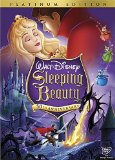| Reviews & Columns |
|
Reviews DVD TV on DVD Blu-ray 4K UHD International DVDs In Theaters Reviews by Studio Video Games Features Collector Series DVDs Easter Egg Database Interviews DVD Talk Radio Feature Articles Columns Anime Talk DVD Savant Horror DVDs The M.O.D. Squad Art House HD Talk Silent DVD
|
DVD Talk Forum |
|
|
| Resources |
|
DVD Price Search Customer Service #'s RCE Info Links |
|
Columns
|
|
|
Sleeping Beauty: Two-Disc Platinum Edition
Walt Disney Studios Home Entertainment // G // October 7, 2008
List Price: $29.99 [Buy now and save at Amazon]
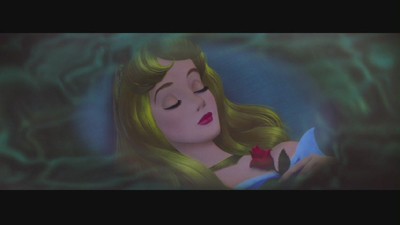
2003 --- ● --- 2008
Note: Click Dates Underneath for Expanded Captures from Each Edition
One clear sign that a masculine movie-goer's taste has evolved with time arrives when they discover that first classic "Disney Princess" film that they adore without any bashfulness. For reference -- no, contrary to recent marketing ploys, Aladdin doesn't count. For me, it wasn't the whimsical romantic magic behind Cinderella that swayed my interest, nor the intriguing bleakness of Snow White's tumultuous mother / daughter relationship that ensnared me into a world of appreciation for Disney's mixture of light and dark themes. Those are all common hooks that lure many into their web of lush beauty, ones that made my outlook change on their quality -- though they did not tap into any emotional resonance.
No, it was Sleeping Beauty's ravishing blend of unique artistic influences, contrasting magical forces, and exciting medieval adventure near the conclusion that shattered my disbelief regarding these fairytales. Once that barrier's broken, they all gradually open up to display treasures you'll find admirable -- but rarely will any ever beat the one that cracks the shell blocking your enjoyment of these great stories. In that right, Sleeping Beauty will always be seen as an astonishing piece of animated gold in these eyes. As it grows alongside me with the years passing, more and more of its hidden mannerisms and amazing visual renderings peek their heads out for further enjoyment.
The Film:
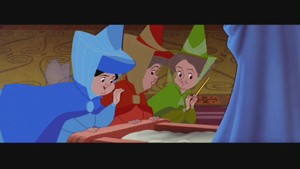
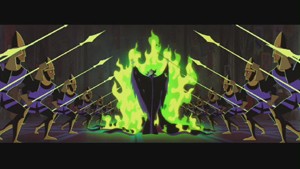
2003 --- 2008 --- ● --- 2003 --- 2008
Sleeping Beauty began production in 1951, roughly a year after Cinderella began its rise to popularity. Walt Disney, according to several people who worked with him on the picture, placed heavy emphasis on differentiating it from his first fame-wielding animated achievement, Snow White. That's understandable, considering both stories share a lot of parallels. In each, there's a princess hunted by a powerfully evil "witch" archetype, a small country cottage where the young girl flees to in sanctuary from the evils of her kingdom, and a group of eccentric secondary characters that take care of her until the time comes for her safe return to the arms of a strong prince. Both follow the Charles Perrault and Brothers Grimm gothic fairytale blueprint, with some added help from Disney in-house author Ted Sears in boosting both ends of the spectrum -- the darker and lighter extremities -- for cinematic adaptation. It's all in refinement and definition, however, that Sleeping Beauty soars well above its other magical predecessors. Much in the vein of Disney's other whimsical creations, strong symbolism and intricacy transform a simple story into an elaborate work of art.
You've got to love their bold, inventive usage of names: it's the story of Princess Aurora, a name that pays homage to the Roman goddess of dawn, as she struggles to dodge the maliciousness of the easily-scorned "mother of all evil" named Maleficent. Some might just see the name Aurora in the pure context of the story as its told to them through storybook fashion, yet it also injects a shot of hopeful foreshadowing in its meaning as well. At her christening, three fairies come to bequeath Aurora with other-worldly gifts. Flora, a name referencing plant-life, gives her beauty in the form of gold in her hair (possibly wheat) and lips as red as the petals of a rose. Fauna, embodying the animals living in nature, gives her the gift of song -- which happens to become the way that she communicates and identifies with the birds, squirrels, and rabbits in the forest later on. It's here that Maleficent, a "malignant" evil-doer rightfully uninvited to the christening, arrives in a scornful attitude and curses Aurora to death by way of spinning-wheel on her sixteenth birthday. To combat this, Merryweather -- a name that references control of, well, weather -- changes the climate of this curse and deems Aurora will instead fall into a deep slumber on this day until she's awoken by love's first kiss. Surely, that would be a kiss from her betrothed Prince Phillip, an arrangement made shortly after her birth in an alliance between her father and another neighboring king.
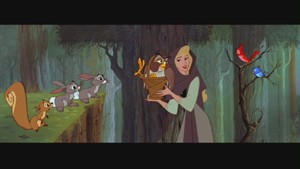
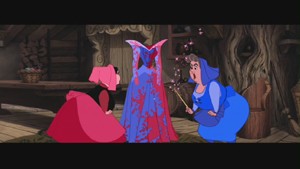
2003 --- 2008 --- ● --- 2003 --- 2008
Worth considering -- referring to all this symbolism and insightfulness amid this fairytale -- is the fact that Sleeping Beauty might be Disney's first real effort at creating an animated film more geared towards adult psyches rather than for the children it would undeniably entertain. Sure, girls would look up to Aurora's attractive qualities as she grows up into a beautiful singing woman in the middle of an amazing forest utopia, and sure, boys would get ramped up by all the action that occurs in the throws of Sleeping Beauty's climactic moments of sword-wielding romanticism. However, there are a lot of adult themes and well-thought concepts that probably slide right above the little ones' heads. It's a tradition that has continued through the string of Disney animated films since then, from the Hamlet-esque Lion King to the surprisingly-mature presence of duality in Mulan -- not Mulan II, mind you, but the original.
One of the funnier moments from the film comes amid a heated conversation between kings Hubert and Stefan as they drink and dine before their children's wedding date; aside from the idea that they grow further and further inebriated and furious with each other, their minstrel sneaks bits of wine in between his plucking and, with time, eventually passes out with his lute over his head. All the while in this scene, and in my other scenes in the film, small facial nuances draw your attention and make you see their gradually-shifting mannerisms. Sleeping Beauty, as a slight diversion from its preceding fairytale brethren, can really surprise with its intricate moods constructed within some rather simple cartoon faces -- something else that children might recognize subliminally, but an element that we gravitate to as adults who watch for these things everyday. Such as with the splatterpaint-dress magical duel between Flora and Merryweather, it satisfies both desires by launching magical bursts for surface-level amusement's sake and by displaying exciting little facial eccentricities for in-tune efforts towards humor.
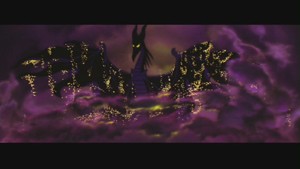
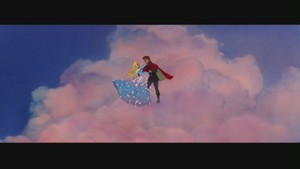
2003 --- 2008 --- ● --- 2003 --- 2008
Part of Sleeping Beauty's universal distinction arises in its pure artistic extravagance as this laundry list of bewildering visual treats saturate its mise en scène. As the first feature-length animated film captured in extra-long Technirama 70, its wide negative stretches clear across the screen in a majestic image built to entrance the audience for all of its seventy-five minutes. Disney's animation succeeds in creating something akin to an in-motion medieval tapestry, which happened to be their desired effect after the production crew found inspiration and influence from real ancient tapestries. Stark usage of both splashes of primary colors and utter saturation of piercing greens and rich browns and purples craft movement with effortless vigor in Sleeping Beauty, much like the story-riddled fabric artwork. You can't help but pay close attention to individual leaves and branches in the forest during "Sequence 8" -- a stretch of wildly intricate nature animation that came close to bankrupting the film all so that Aurora could sing to her animal friends -- and to the ravishing textures in wood grains and dimly-lit bricks at both the forest cottage and Maleficent's ominous castle. It's all so vivid that it paints an experience right before your eyes: a story that can be told within 5 minutes, stretched into an hour-and-fifteen minute tale that many wish to be even longer.
Even considering all that, it's only in the last twenty-or-so minutes that Sleeping Beauty really gets down to business and becomes an entertainment unlike many other fantasy films, animated or live action. From the start when Maleficent tries to drape a black cloud over Aurora's existence, everything has built up to three key fairytale pay-offs: the life-threatening conflict, the epic battle between good and evil, and the climactic pinnacle kiss. Yeah, we know they're coming; whether that makes the whirlwind of swirling green fire, billowing purple clouds, and lavish swiping of the Great Sword of Truth more or less of a payoff becomes inconsequential when this story reaches such an electric climax. There's so much to love in these grandiose theatrics -- from the fairy's support in helping the prince, all the way to his dramatic battle with the unbelievably-crafted black dragon that thrashes and destroys the landscape of Maleficent's castle -- that they almost make the whole film worth watching even if sappy stories of medieval prince / princess love aren't your thing. As someone who relishes in quality animation and the power of majestic fairytales, Sleeping Beauty easy stands as that one of Disney's line of princess narratives that I can really soak into many times over.
The DVD:
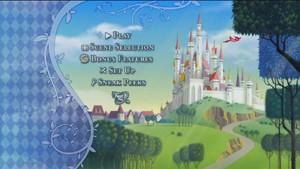
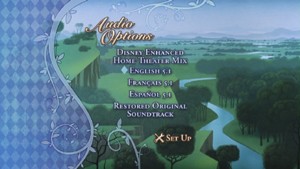
Sleeping Beauty's 50th Anniversary DVD represents one of the few Disney Platinum Editions to replace a strong previous package. Here, Disney offers the new Platinum Edition with a nice embossed purple-shaded slipcover with a pearlescent shine in several points on the cardboard slipcover -- think Pirates of the Caribbean: Dead Man's Chest. Inside is a chapter listing booklet, one that's not quite as beefy as the previous edition. Both of the discs have a glossy purple sheen on top of their attractive artwork, though the second one looks almost identical to Disc 2 from the 2003 Edition.
The Video:
Disney's previous 2.35:1 widescreen transfer for Sleeping Beauty is, of course, fantastic; when looking back at the transfer, one that's aged five (5) years, it does have digital flickering and a few blips and scratches in its lightly-pictureboxed image. Texture, detail, and color solidity are all handled beautifully in its widescreen-enhanced image, though. It's a phenomenal effort that embodies the essence of the film splendidly.
For its 50th Anniversary, The House of Mouse has revisited Sleeping Beauty's image for improvement's sake. You should've seen the look on my face when I first heard the commercial for this new Platinum Edition: "Never-Before-Seen Expanded (or Extended) Version" echoed in the speakers of my sound system as I was in the next room preparing a cup of tea. Eyes widened and ears perked as slight concern flowed over the sound of that -- though I didn't see with my eyes what it meant. After seeing the commercial later on that evening, my concern was replaced with excitement. Sleeping Beauty's image would be cleaned up and "expanded" to an even-wider image than its previous effort to a staggering 2.55:1 image. Wow.
Once I popped the disc in, fresh after sparking my memory of the previous image, the sight before my eyes was really something. Sleeping Beauty now revealed elements unseen in most home video efforts. Did you know that Fauna (the green fairy) was actually watching Flora (red fairy) and Merryweather (blue fairy) float about and fight over wands in their first quarrel? It's not really seen until after the little spat when the image pans over and reveals her to the side. That's one of many elements reinvigorated in the image, which includes expanded scenery, more visible dinnerware on tables, and some elements in the fairy's cottage unseen. That, in itself, is a grand reason to relish in this new image.
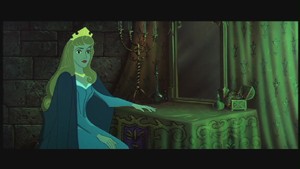
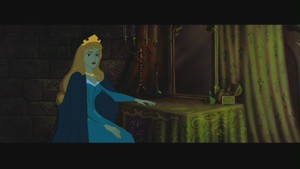
Left = 2003 Special Edition, Right = 2008 Platinum Edition
Click Each for Larger Image
Now, the coloring. Much like their effort with Peter Pan, some major palette "refinements" have been introduced to the artwork -- which includes extra saturation, desaturation, and hue adjustments. And, like with Peter Pan, there are a few questionable implementations that might lean away from the original artwork ideas. In most cases here, however, the changes lean towards a more agreeable and natural tonality that adds depth and dimensionality to the image. A few portions of Sleeping Beauty, in particular the scene that features Aurora as she first walks towards the green flames of the spinning wheel later in the film, seem a little off. Where that original image embodies the boisterous green flames, letting the shading soak into the backdrop, her clothing, and her hair, this new image neglects to tint these parts in the loud style as it does in the original print.
Instead of coating it all with the natural greenish glow that would accompany fire-touched portions, it lends more of a glowing effect: her hair is a brownish hue, her golden jewelry somewhat orange, and her clothing still very blue. In motion, it looks surprisingly natural as the greenish hues gracefully intensify as she grows closer and closer. Though it's a troublingly colored scene, however, it's the only one that seemed "off" to me to a degree that sparked questionability in the restoration effort. When you take a look at, say, Fauna's green-shade layered outfit and compare it to the concept galleries from the previous Sleeping Beauty DVD, the colors appear fairly spot-on in most scenes -- other times, though, she seems a little bit on the olive side.
Outside of the color issues, this new image is a splendid effort as a whole. The contrast work, though it masks some of the minor details in clothing and backdrops a bit, renders the image to be much more three-dimensional. Color strength comes across with rock-solid substance and added warmth, rarely flickering or wavering in tone. This warmer feeling can be seen well in the cottage scenes, though Disney's questionable threshold for green shades creates more "natural" tanned wood tones instead of an ever-present greenish veil. Sharpness competency, namely a balance between overly-sharp backdrops and prominent characters on-screen, echoes similar substantial improvements. I did, however, spot a scene or two with a bit of visible edge-enhancement along sharp lines, such as in the hallway bit with Maleficent and the spear-wielding guards. They're fairly unnoticeable, more like muddy blotches than radiation-type halos, but they're still present. Sleeping Beauty's new wider restored image still looks fantastic in all its rich, bold glory -- even considering a few inconsistent and questionable patches.
The Audio:
Where a few oddities mar the image in a way that reduces it to a not-so-pristine effort, there's no question in the aural department: hands down, this new Dolby Digital 5.1 audio track trumps its predecessor in clarity, fidelity, and overall cinematic essence. Sleeping Beauty sounds absolutely fantastic from start to finish here, removing much of the raspy quality present in the older edition's verbal and musical efforts. As to be expected, minimal use is made of the lower-frequency channels, but when needed it does stand up to task in billowing out a few mid-range notes. But the star of this show is the verbal clarity, which just sounds magnificent! Disney has stepped up to the task in providing a standard audio track stands its own against some higher-definition efforts of films in the same spectrum.
Also included is the "Original Theatrical Audio", which preserves the more accurate "Hollow" properties about the track. It's plenty strong as well for purists that wish to steer clear of the well-mixed enhanced Home Theater option. Optional English, French, and Spanish subtitles are available, as are Spanish and French 5.1 tracks.
The Extras:
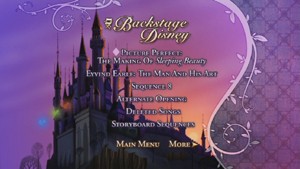
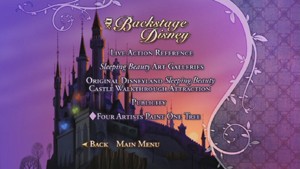
The definition of "exhaustive" refers to the fact that something either contains all elements or tests all possibilities -- something that Sleeping Beauty's new 2-Disc Platinum Edition accomplishes with end barely in sight. Hardly anything from the 2003 Special Edition has been dropped, in turn replacing any of this skimmed fat with quality supplements that easily replace those empty gaps. Some classy and enjoyably extensive material has been slathered on top of this already-robust package from the previous edition.
On Disc One (1) ...
Audio Commentary with John Lasseter, Critic Leonard Maltin, and Lead Animator Andreas Déja:
The old Audio Commentary takes a prolonged period of time in introducing each and every participant in the track while it takes on a proper convention-style moderation. The content focuses heavily on animation design and structure, along with how they found their inspirations. It's an amazing commentary track that, sadly, is NOT available on this new disc -- though, I believe snippets of it have be integrated into this new track. At the very least, some bits and pieces from the previous commentary's contributors pop up for informational purposes intermittently. Instead, we've got this knowledgeable trio of animated Sleeping Beauty-philes that dig deep into the craftsmanship of the film. They discuss everything from analyzing character shapes -- especially the fairies -- to some of the same history covered in the previous commentary. It's a much more relaxed and comfortable track than the original, but it never ceases to provide enamored words of appreciation and significant insight.
Peter Tchaikovsky Story:
Ready to take a leap backwards in time? Then check out Walt Disney's introduction at the beginning of the Peter Tchaikovsky Story, where it instructs you how to get true stereophonic sound via your radio. It starts off the television program with a nice kitschy feel -- though it's much too long for its own good. About 30 minutes in to the program, however, you get the opportunity to see some "preview material" for Sleeping Beauty presented in widescreen for the program. Early non-anamorphic, black-and-white animation at its finest.
Grand Canyon:
This is an instrumental capturing of the Grand Canyon played with many showings of Sleeping Beauty during its run. It reminds me of a peaceful, un-symbolic rendition of Koyanisquatzi.
Also included is a Music Video of a rendition of "Once Upon a Dream" performed by Emily Osment, and a specific Song Selection option where you can play just the songs from the film over a seven (7) minute period. On-screen lyrics are available for that portion.
What's New On Disc Two (2) ...
Picture Perfect: Making of Sleeping Beauty:
A phenomenal fourty-five (45) assembly featurette that replaces the pithy 16-minute feature on the old disc, this piece stretches all the way from Disney's initial conceptualizations early in the '50s all the way to the core of the production values revolving around character outlines and movement. There's a huge host of interviewees here, ranging from animations and costume designers to the voice actors in the film. Furthermore, the still photographs that help the dialogue of the featurette along are phenomenal, which include still shots from the "acted" behind-the-scenes pre-visualizations to captures of the animators painting and sketching the characters.
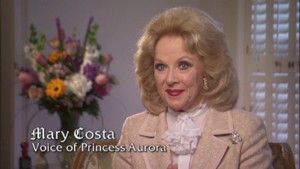
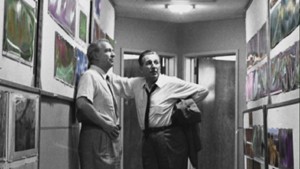
Eyvind Earle: The Man and His Art:
Concentrating solely on background designer Eyvind Earle, this featurette concentrates on his full history and participation on the film. It mentions his work as a glass painter, his troubles with his family, as well as his development as an artist.
Sequence 8:
Sequence 8 is Aurora's big forest scene, the pivotal moment in the film that introduces our prince, her romantic whims, and her connection with animals. Instead of romantically looking back on the scene, it highlights the strife they suffered through - as well as the problems with that one scene's costly budget.
Alternate Opening
Storyboards and sketches illustrate a different idea on the initial book sequence at the start of the film. It introduces Princess Aurora's christening, as well as the possibility of it starting with a musical number singing about a "holiday". Interesting stuff.
Deleted Songs:
Once again, sketches adorn conceptualizations of a few Deleted Songs. The three songs are entitled, "It Happens I Have a Picture" (which contains two different versions), "Riddle Diddle", and "Go to Sleep".
Castle Walkthrough:
Nearly eight (8) minutes of walkthrough that takes us through this reconstruction of a Castle Attraction, also available with narration and diorama illustration with Tony Baxter. It's also presented with a historical reference track.
Games:
Two games are available for the younger crowd: Briar Rose's Enchanted Dance Game, and Sleeping Beauty: Fun With Language Game. Trust me: both of these are painful for adults.
Ported from 2003 Special Edition ...
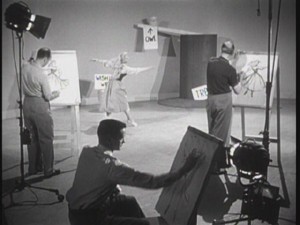
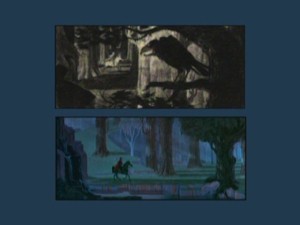
Storyboard Sequences
There's nothing more that I enjoy peering into with animated films than the pre-concept storyboards -- and comparing their differences and likenesses. Here, the "Fairies Put the Castle To Sleep" and "The Capture of the Prince" scenes are compared in such a way, going to split-screen to illustrate their contrasts.
Live-Action References:
Roughly two-and-a-half minutes of filmed sequences adorn this section. These are pieces of footage used to mold the animation towards the movements of their tangible subjects. It's a technique that has stayed in practice throughout the years, even with Disney's newer batch of animal films.
Sleeping Beauty Art Galleries:
Thankfully,this portion has been reconstructed from the older art gallery segment. In that one, you navigate through brick-laden rooms, all the while turning and shifting to see new pictures. Here, it'a all just stripped down for you to easily point-and-click for easy sifting with a nicely-pattered purple background. Furthermore, other segments such as the "Publicitiy section have also been reconstructed with the new background for uniformity. Here's the line-up:
Visual Development
Character Design
Storyboard Art
Live-Action Reference
The Sleeping Beauty Storybook
Layouts and Backgrounds
Production Photos (aka "Scrapbook")
Publicity
Publicity:
Here, we've got the Trailer Gallery ported over from the old edition which, sadly, did not enhance the full trailer to widescreen-enhanced status. There's an original roadshow Teaser Trailer, the aformentioed Full Trailer, and a Re-issue Trailer from 1995.
Four Artists Paint One Tree:
In a sixteen-minute feature, we're taken through four Disney artists' process in crafting a tree. It's a great way of showing differentiation in signs, also featuring Wal Disney's "advice" to artists. It applies to Sleeping Beauty since it features the four artists' contribution to Sleeping Beauty. It's a great feature that shows how teamwork is integral during these massive productions.
-----
Final Thoughts:
For its 50th Anniversary, Disney has brought out the big guns with a shimmering new 2.55:1 transfer, a sublime fresh audio mix, and a fantastic collage of old and new supplements for a comprehensive Sleeping Beauty package. The animated film itself is a real piece of work, integrating old and new concepts from the '50s House of Mouse into a medieval fantasy packed with equal parts ominous theatrics and gloriously vibrant fairytale radiance. If you've never actually seen Sleeping Beauty, then you should know that there's no reason in the world for you not to now. It's a tale for the ages that develops more and more with maturity and fondness for the material.
Disney has nailed a huge chunk of bullzeyes with this new Platinum Edition DVD, especially with this new home theater audio mix and the exquisite behind-the-scenes material fresh for this edition. The image also provides a beautiful visual experience, though some of the color inquiries leave me a bit hesitant. However, the opportunity to see the film in its full Technirama aspect ratio is reason enough to upgrade for the picture. Along with aware of the old edition's strong suits and some fresh anniversary spit polish, this new two-disc package of Sleeping Beauty comes with a hearty High Recommendation. If you never felt like picking up the 2003 Special Edition due to its out-of-print price spikes, then this now-circulating package provides a comprehensive experience that captures the essence of Disney's fairytale beautifully.
|
| Popular Reviews |
| Sponsored Links |
|
|
| Sponsored Links |
|
|
| Release List | Reviews | Shop | Newsletter | Forum | DVD Giveaways | Blu-Ray | Advertise |
|
Copyright 2024 DVDTalk.com All Rights Reserved. Legal Info, Privacy Policy, Terms of Use,
Manage Preferences,
Your Privacy Choices | |||||||









